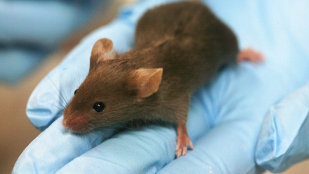Genetics hold far more sway over the mouse microbiome than transient environmental exposures, researchers reported July 26 in Applied and Environmental Microbiology. The results appear to contradict previous studies in humans that have found environmental factors to be more influential than genetics, and they add to an ongoing dialogue in the microbiome research community over how much control we hold over the bacterial communities in our guts.
Hila Korach-Rechtman, a microbiologist at the Israel Institute of Technology in Haifa, set out to identify the microbes in mice that become a fixture in the gut after being introduced through the environment. “We really wanted to find these bacteria that can be transferred and remain in the host, even though they have different genetics,” she says.
Instead, the investigators found that environmental factors exert only temporary effects, much like probiotic supplements that only populate the gut with certain bacteria as long as they are taken.
The researchers arrived at their unexpected results after first analyzing the microbiomes of two distinct laboratory mouse strains, C57BL/6J and BALB/c. The scientists crossed the mice, which have black and white fur, respectively, to develop two groups of genetically similar gray offspring, some with a black mother and white father, and others with a white mother and black father. The scientists then compared the gut microbial composition of the hybrids to one another and to inbred C57BL/6J and BALB/c mice to see if the microbiota better aligned with their parents’ microbes or with their fellow hybrids’.
Studies in various species suggest that passing through the birth canal seeds newborns’ microbiomes with bacteria from their mothers, so the researchers expected to see certain microbes passed between mother and pup, regardless of their genetic backgrounds.
“To our great surprise, we saw that the maternal effect was absent,” says Korach-Rechtman. “We saw three different patterns of microbiome,” one black, one white, and one gray, each matching up with the genetic signature of its coinciding strain, she says. “What we concluded is that each [genetic] line has a bacterial signature of its own.”
Korach-Rechtman and her colleagues wanted to “challenge the genetics” by placing black and white mice within the same environment. Mice are coprophages, meaning they consume each other’s feces and thereby transfer microbes from one gut to the next. Over 10 weeks of cohabitation, the animals’ microbiomes began to resemble one another’s. But once the mice were separated and housed with mice of the same genetic line, each animal reverted to its original microbial composition, one that better matched that of mice with the same genetic background.
The researchers identified 12 bacterial taxa, in particular, that displayed genetically controlled gut persistence. They were able to track these taxa across generations to see which were passed down through dominant or recessive inheritance.
“The levels of those microbes would match either the BALB or the B/6, so the BALB or B/6 allele appears to be dominant if that gut microbe’s abundance matched the parental strain,” says Angela Poole, a geneticist and computational biologist at Cornell University in Ithaca, who was not involved in the study. The researcher’s “clever” study design allowed them to spot this pattern, Poole says.
Despite its experimental novelty, the study’s results may not allow “such a broad conclusion [to] be reached in the general case, even in the mouse setting,” says Eran Segal, a computer scientist and computational biologist at the Weizmann Institute of Science, who was not involved in the study. Segal previously determined that only about 1.9–8.1 percent of the human microbiome is heritable, based on a study of 1,046 Israeli adults and additional research in related individuals.
He notes that the 12 taxa highlighted in the mouse study represent an unknown percentage of the microbiome, and therefore can’t capture how much of its composition may be dominated by genetics. It’s also unclear how much of each mouse’s microbiome can be transferred through coprophagy. He suggests it would be interesting to “reverse” the cohabitation experiment entirely.
“For instance, what would happen if they took mice who are identical genetically, but subjected them to very different environments? If many taxa differed in such a setting then the conclusion would be that environment dominates more,” says Segal in an email to The Scientist. “This would mimic more the case in humans, where we each have a unique environment.”
Overall, scientists recognize that both genetics and the environment sculpt the gut microbiome, says Poole, regardless of which “camp” they fall under.
“Genetics is a significant factor influencing gut microbiome composition,” says Poole, but environmental factors, such as diet, must be equally acknowledged to understand how these microbial populations arise and change. “All these variables are really important—that’s the take-home message.”
H. Korach-Rechtman et al., “Murine genetic background has a stronger Impact on the composition of the gut microbiota than maternal inoculation or exposure to unlike exogenous microbiota,” doi:10.1128/AEM.00826-19, Appl Environ Microb, 2019.







